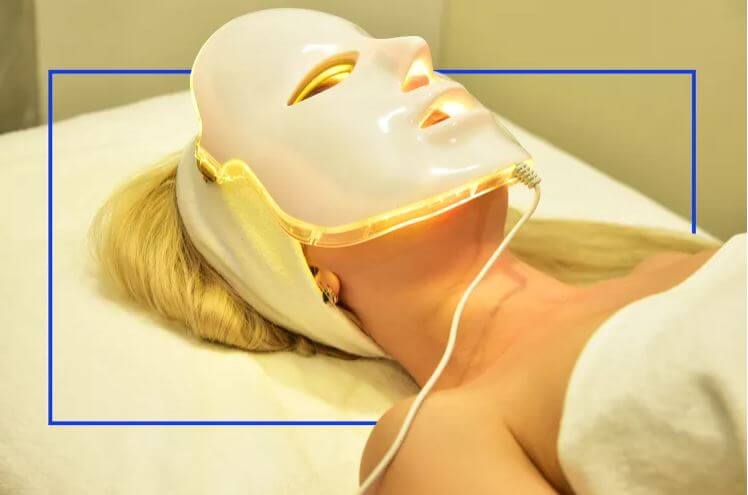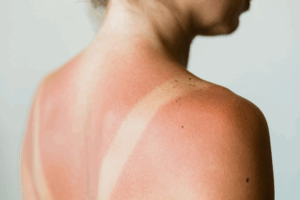Read Full Article HereLight therapy masks are having a moment across social media. Celebrities and influencers alike have shared selfies and videos using LED light therapy masks to help improve skin. While it’s fun to see
everyone looking like a Star Wars Stormtrooper for the sake of better skin, does exposing your skin to this type of light actually have an impact? Or is it just a gimmick?To get to the bottom of this question, we’ve asked board-certified dermatologists to weigh in on whether or not at-home light therapy masks can improve your skin. Here’s everything you need to know about at-home light therapy masks, from potential benefits and risks to tips for getting the best results.
What Are Light Therapy Masks and How Do They Work?
Light therapy masks are wearable devices that emit different wavelengths of light to treat skin concerns, explains board-certified dermatologist Jean Charles, DO, FAAD. “They work by utilizing wavelengths of light to target different chromophores in our skin to stimulate cell activities and functions leading to specific results in our skin.”
To get more scientific about it—the photons, or light particles, released by the LEDs (AKA light-emitting diodes) in the mask are absorbed by light-sensitive receptors in skin cells, resulting in the process of photobiostimulation. “This process causes a number of biological changes in the skin, such as accelerated wound healing, synthesis of collagen and elastin, the elimination of the bacterium C. acnes that causes acne, and a decrease in hyperpigmentation,” explains Rosmy Barrios, MD.
At-home light therapy masks vary based on the product and manufacturer, but typically, they’re worn for 10 to 20 minutes at a time. “It’s important to note that at-home light therapy masks may not be as powerful as professional treatments performed in a dermatologist’s office,” says cosmetic beauty chemist David Petrillo. “The intensity and effectiveness of the light therapy can vary depending on the device.”
Potential Benefits of Light Therapy Masks for Different Skin Conditions
At-home light therapy masks have made light therapy treatment more popular and accessible. However, dermatologists have used LED light to treat skin concerns for quite some time. Here, board-certified dermatologist Dustin Portela, DO breaks down the nuances.
Red Light: Most commonly used for anti-aging benefits, the red light stimulates collagen production, helping reduce the appearance of fine lines and wrinkles.
Blue Light: Used for its antibacterial properties, blue light reduces inflammation, helps to prevent future breakouts, and targets the bacteria responsible for causing acne.
Green Light: Often used to reduce hyperpigmentation and even out skin tone, green light targets the cells responsible for producing melanin and aids in breaking up excess pigment in the skin.
Yellow Light: Known for its soothing and calming effects on the skin, yellow light can help reduce redness, inflammation, and irritation. Yellow light also can be beneficial for people with rosacea-prone or sensitive skin.
Infrared Light: This type of light penetrates deeper into the skin than other colors and is often used to help improve circulation, reduce inflammation, and promote wound healing.Potential Risks and Side Effects of Light Therapy Masks
Experts agree that overall, there are no major risks to using at-home light therapy masks. “Sometimes people wonder whether these devices can cause facial burns, but the infrared radiation from these masks only heats up the facial tissues without any possibility of burning,” explains Barrios. That said, she stresses the importance of making sure the at-home light therapy mask you purchase comes from a reputable supplier—one that ideally has been approved for use by the Food and Drug Administration (FDA).
When using an at-home light therapy mask, protecting your eyes is important. Use the protective eyewear your mask comes with. Also, operate the device according to the manufacturer’s instructions. If your mask does not include protective eyewear, consider investing in a pair that fits your mask.
If you have sensitive skin or are taking certain medications, using an at-home light therapy mask may not be the best choice for your skin. “While light therapy is generally well-tolerated, some
individuals may experience mild, temporary side effects such as redness, dryness, or irritation,” says Petrillo. “These side effects typically subside shortly after treatment.”Reviewing the Scientific Evidence: Are Light Therapy Masks Effective?
Though at-home light therapy masks are a fairly new product to hit the market, the results from initial studies have been promising, says Howard Sobel, MD, clinical attending dermatologic surgeon at Lenox Hill Hospital. “According to several published studies, there is evidence that LED masks treat fine lines and aging concerns by boosting collagen, improving skin elasticity, and clearing up acne,” A study published by the Journal of Investigative Dermatology found that at-home LED masks effectively reduced signs of aging.
However, most dermatologists agree that an at-home light therapy mask is not a quick fix or cure-all for skin issues. “At-home light therapy masks can be beneficial, but only if you already have a good skincare routine that you use consistently,” says Portela. “If you aren’t in the habit of wearing sunscreen and using retinol, don’t look to light therapy to turn back the clock on your skin.”
Are Light Therapy Masks Worth the Investment?
For at-home light therapy masks to be worth the investment, they must be used with a skincare routine that includes proper cleansing and moisturizing, consistent SPF, and retinol. It’s also important to note that the results take time to achieve.
“These devices are generally safe because they use lower energies, which means results will take a longer period of time,” says Portela. “So, be patient and consistent when using your device.”
As with any new skincare treatment, consult a dermatologist to help you understand the different types of masks on the market and which light colors are most suitable for your skin type and concern. “If you have sensitive skin, your healthcare provider will be your best source of information,” says Portela.
Do Light Therapy Masks Really Work?
August 28, 2023








